Speak directly to the analyst to clarify any post sales queries you may have.
The mineral wool market is undergoing accelerated change as companies navigate new regulations, sustainability targets, and shifting standards in construction and infrastructure. For senior decision-makers, adapting supply strategies and compliance practices is now a priority to maintain growth and operational continuity amid the sector’s rapid evolution.
Market Snapshot: Mineral Wool Market Growth and Opportunity
The mineral wool market is valued at USD 23.13 billion in 2024, experiencing robust demand across construction and industrial applications. With a projected CAGR of 8.36%, revenues are set to reach USD 25.09 billion by 2025 and approach USD 44 billion by 2032. This trajectory is supported by increasingly stringent global energy efficiency measures and heightened fire safety requirements. Builders and technical specifiers seek high-performance, compliant insulation to address both regulatory obligations and end-user needs. Companies adapting to new compliance regimes and modernizing their production infrastructure stand to access emerging markets and sustain long-term competitiveness.
Scope & Segmentation of the Mineral Wool Market
Analyzing the mineral wool market through a detailed segmentation model equips leaders to align resources and sharpen innovation across core businesses. A structured approach to segmentation helps prioritize procurement and investment as regulations and technologies advance.
- Material Types: Mineral wool encompasses glass wool, rock wool, and slag wool. Each contributes to enhanced fire resistance, noise mitigation, and sustainable building certifications for both new projects and retrofits.
- Forms: Insulation solutions are offered as blankets, rolls, boards, molded components, and pipe sections. This assortment enables flexible system design, supports varied installation needs, and fits multiple sectors—commercial, industrial, and residential.
- Applications: Key uses include supporting advanced fire protection, promoting sound management, and facilitating projects striving for strict energy performance standards in line with evolving codes.
- End Users: Commercial developers, industrial operators, and residential construction teams select mineral wool to ensure compliance, reinforce site resilience, and achieve consistent project outcomes.
- Distribution Channels: Traditional supply models are giving way to digital procurement, streamlining logistics and increasing flexibility in servicing diverse projects and geographies.
- Geographic Regions: The market is shaped by established energy and safety standards in the Americas and Europe, while growth in Asia-Pacific, the Middle East, and Africa is accelerating due to regulatory reform and construction expansion—particularly in China, India, and parts of Southeast Asia.
- Leading Companies Assessed: The market analysis includes Owens Corning, ROCKWOOL International A/S, Johns Manville Corporation, Knauf Insulation GmbH, Compagnie de Saint-Gobain S.A., Paroc Group Oy, Armacell International S.A., URSA Insulation S.L., Kingspan Group plc, and NMC SA, reviewed for product innovation, extensive portfolios, and international reach.
Key Takeaways for Senior Decision-Makers
- Proactively track and interpret evolving compliance demands to maintain market access and avoid operational or reputational setbacks.
- Expand adoption of digital procurement tools and upgrade supply networks to support operational consistency and minimize project disruption, especially on multisite initiatives.
- Strengthen responsible sourcing and manufacturing efficiencies to align with the latest environmental mandates and respond to sustainability commitments across the value chain.
- Invest in R&D and collaborative partnerships to advance insulation performance, emphasizing innovations in acoustic attenuation and moisture resilience.
- Shape regional strategies to accommodate varying logistical requirements and regulatory expectations, ensuring precise delivery and consistent execution in target growth markets.
Tariff Impact: Navigating Cost and Sourcing Pressures
Procurement strategies must adjust continually in response to global tariff shifts. Enhancing local manufacturing operations, building strong supplier relationships, and considering vertical integration can help minimize exposure to fluctuating input expenses. A distributed sourcing model further bolsters business continuity and improves responsiveness to changing market conditions.
Methodology & Data Sources
This report synthesizes sector leader and expert interviews with technical documentation and proprietary data from company sources, providing an up-to-date analysis rooted in actual industry dynamics.
Mineral Wool Market: Why This Report Matters
- Equips organizations with frameworks for regulatory risk management and operational compliance tailored to the current and anticipated standard landscape.
- Facilitates adoption of sustainable procurement and digital workflows, enabling better preparedness for escalating environmental and efficiency demands.
- Enhances supply chain and project planning by highlighting opportunities to build resilience and apply innovative approaches from procurement to on-site delivery.
Conclusion
Applying these insights enables executive teams to maintain competitive strength, implement agile business practices, and confidently adapt to ongoing structural and regulatory changes in the mineral wool market.
Additional Product Information:
- Purchase of this report includes 1 year online access with quarterly updates.
- This report can be updated on request. Please contact our Customer Experience team using the Ask a Question widget on our website.
Table of Contents
3. Executive Summary
4. Market Overview
7. Cumulative Impact of Artificial Intelligence 2025
Companies Mentioned
The companies profiled in this Mineral Wool market report include:- Owens Corning
- ROCKWOOL International A/S
- Johns Manville Corporation
- Knauf Insulation GmbH
- Compagnie de Saint-Gobain S.A.
- Paroc Group Oy
- Armacell International S.A.
- URSA Insulation, S.L.
- Kingspan Group plc
- NMC SA
Table Information
| Report Attribute | Details |
|---|---|
| No. of Pages | 185 |
| Published | October 2025 |
| Forecast Period | 2025 - 2032 |
| Estimated Market Value ( USD | $ 25.09 Billion |
| Forecasted Market Value ( USD | $ 44 Billion |
| Compound Annual Growth Rate | 8.3% |
| Regions Covered | Global |
| No. of Companies Mentioned | 11 |









